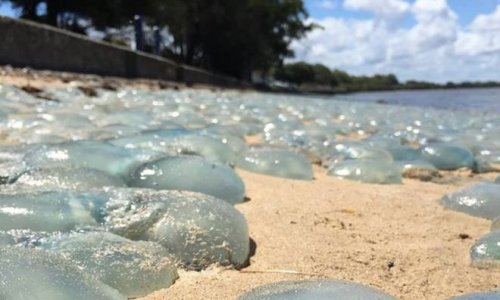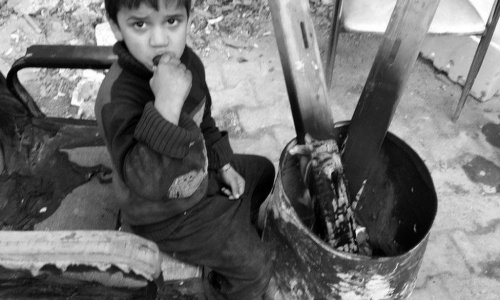Lake Urmia in the northwestern corner of Iran, one of the largest permanent hypersaline lakes in the world and the largest lake in the Middle East, has turned blood-red, blamed on a combination of drought and increased water diversion for irrigated agriculture within the lake's watershed as well as mismanagement.
"I flied over Lake Urmia, three weeks ago. It is not in a good condition and it has turned red. I saw no birds around the lake and I estimate that the level of water in the lake shrunk to less than one-third of its original volume," Esmail Kahrom, an advisor to the head of Department of Environment of Iran, described the latest situation of the lake in an interview with Trend.Drying up Lake Urmia, once known as a very important seasonal habitat for many species of migrating birds, is no longer a home to those 200 species of birds (including pelicans, egrets, ducks and flamingos) documented on the lake and its surroundings.
seasonal habitat for many species of migrating birds, is no longer a home to those 200 species of birds (including pelicans, egrets, ducks and flamingos) documented on the lake and its surroundings.
 seasonal habitat for many species of migrating birds, is no longer a home to those 200 species of birds (including pelicans, egrets, ducks and flamingos) documented on the lake and its surroundings.
seasonal habitat for many species of migrating birds, is no longer a home to those 200 species of birds (including pelicans, egrets, ducks and flamingos) documented on the lake and its surroundings.However, Turkey’s Lake Van, just about 170 kilometers (km) far from Urmia, does not show the dramatic change apparent in its Iranian counterpart, as Esmail Kahrom’s personal observations suggest that the largest lake of the neighboring country is still deep blue.
Both lakes are fed by mountain streams and they have no outlets, except for evaporation, allowing salts and minerals to build in the lakes.
Photos depicting the lake’s shoreline show the salt left behind as the lake retreats, a warning of an unfolding ecological disaster which could leave much of the lake bed a salt-covered wasteland leading to serious negative impacts on local agriculture and livelihoods as well as regional health.
The diversion of streamflow by the many dams built in the Urmia basin is believed to be among the main reasons behind the lake’s drying up.
The watershed of the lake is an important agricultural region with a population of around 6.4 million people, while an estimated 76 million people live within a radius of 500 km, according to a report by United Nations Environment Programme (UNEP).
agricultural region with a population of around 6.4 million people, while an estimated 76 million people live within a radius of 500 km, according to a report by United Nations Environment Programme (UNEP).
 agricultural region with a population of around 6.4 million people, while an estimated 76 million people live within a radius of 500 km, according to a report by United Nations Environment Programme (UNEP).
agricultural region with a population of around 6.4 million people, while an estimated 76 million people live within a radius of 500 km, according to a report by United Nations Environment Programme (UNEP).Research works suggest that climate change and diversion of surface water for upstream use, construction of dams and decreased precipitation over the lake itself are the most important reasons for water decline in the lake.
Since President Hassan Rouhani took office in 2013, he has pledged to back efforts aimed at protecting and restoring the controversial lake.
Over the past couple of years the government has passed several bills on funding projects to help protect the drying up lake, which was declared a Wetland of International Importance by the Ramsar Convention in 1971 and designated a UNESCO Biosphere Reserve in 1976.
Earlier in September, the government decided to allocate about $93 million (three trillion rials) to a working group in charge of restoring the lake.
However, Isa Kalantari, the head of working group for the restoration of Lake Urmia, has recently revealed that the implementation of projects for reviving the lake has been halted due to lack of funds.
Speaking to Trend on the issue, Fatemeh Javadi, a former Iranian vice president who headed the Department of Environment in 2005-2009, blamed the current situation of the Lake Urmia on mismanagement at the incumbent government accusing the officials of wasting funds and refusing to stick with plans drawn up to save the lake during ex-President Mahmoud Ahmadinejad’s term.
This is while a high-ranking official with Iran’s Department of Environment responded to Trend’s inquiry rejecting Fatemeh Javadi’s remarks.
rejecting Fatemeh Javadi’s remarks.
 rejecting Fatemeh Javadi’s remarks.
rejecting Fatemeh Javadi’s remarks."President Ahmadinejad’s government did too little to save the lake and I am very pessimistic about the future of the lake. Currently, rainfall is the only hope [for saving the lake]…," the official, who spoke to Trend on condition of anonymity, said.
It’s time for officials to give up political approaches and take serious steps to prevent an imminent disaster.
The blood-red color of "once a giant salt lake" is not only a sign of the climate change, but also sets the alarm bells ringing for those concerned about the health of almost 80 million individuals living within a radius of 500 km inside and outside the country as the windblown salt-storms do not recognize any borders.
A prompt action for restoring the lake and saving millions of lives is required on both levels, national and international.
(Trend)



www.ann.az
Follow us !











